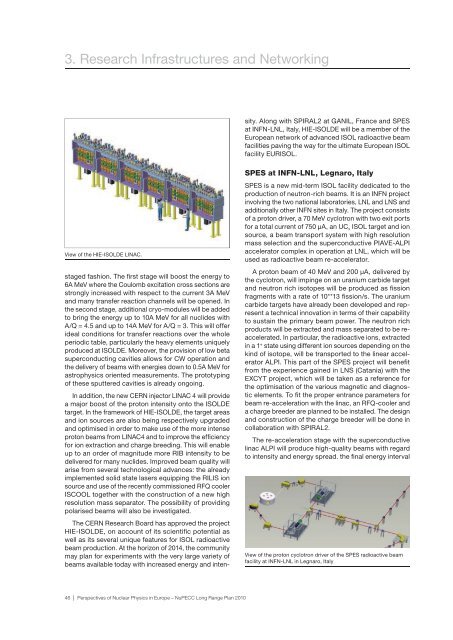Perspectives of Nuclear Physics in Europe - European Science ...
Perspectives of Nuclear Physics in Europe - European Science ...
Perspectives of Nuclear Physics in Europe - European Science ...
Create successful ePaper yourself
Turn your PDF publications into a flip-book with our unique Google optimized e-Paper software.
3. Research Infrastructures and Network<strong>in</strong>g<br />
The CERN Research Board has approved the project<br />
HIE-ISOLDE, on account <strong>of</strong> its scientifi c potential as<br />
well as its several unique features for ISOL radioactive<br />
beam production. At the horizon <strong>of</strong> 2014, the community<br />
may plan for experiments with the very large variety <strong>of</strong><br />
beams available today with <strong>in</strong>creased energy and <strong>in</strong>tensity.<br />
Along with SPIRAL2 at GANIL, France and SPES<br />
at INFN-LNL, Italy, HIE-ISOLDE will be a member <strong>of</strong> the<br />
<strong>Europe</strong>an network <strong>of</strong> advanced ISOL radioactive beam<br />
facilities pav<strong>in</strong>g the way for the ultimate <strong>Europe</strong>an ISOL<br />
facility EURISOL.<br />
View <strong>of</strong> the HIE-ISOLDE LINAC.<br />
staged fashion. The first stage will boost the energy to<br />
6A MeV where the Coulomb excitation cross sections are<br />
strongly <strong>in</strong>creased with respect to the current 3A MeV<br />
and many transfer reaction channels will be opened. In<br />
the second stage, additional cryo-modules will be added<br />
to br<strong>in</strong>g the energy up to 10A MeV for all nuclides with<br />
A/Q = 4.5 and up to 14A MeV for A/Q = 3. This will <strong>of</strong>fer<br />
ideal conditions for transfer reactions over the whole<br />
periodic table, particularly the heavy elements uniquely<br />
produced at ISOLDE. Moreover, the provision <strong>of</strong> low beta<br />
superconduct<strong>in</strong>g cavities allows for CW operation and<br />
the delivery <strong>of</strong> beams with energies down to 0.5A MeV for<br />
astrophysics oriented measurements. The prototyp<strong>in</strong>g<br />
<strong>of</strong> these sputtered cavities is already ongo<strong>in</strong>g.<br />
In addition, the new CERN <strong>in</strong>jector LINAC 4 will provide<br />
a major boost <strong>of</strong> the proton <strong>in</strong>tensity onto the ISOLDE<br />
target. In the framework <strong>of</strong> HIE-ISOLDE, the target areas<br />
and ion sources are also be<strong>in</strong>g respectively upgraded<br />
and optimised <strong>in</strong> order to make use <strong>of</strong> the more <strong>in</strong>tense<br />
proton beams from LINAC4 and to improve the efficiency<br />
for ion extraction and charge breed<strong>in</strong>g. This will enable<br />
up to an order <strong>of</strong> magnitude more RIB <strong>in</strong>tensity to be<br />
delivered for many nuclides. Improved beam quality will<br />
arise from several technological advances: the already<br />
implemented solid state lasers equipp<strong>in</strong>g the RILIS ion<br />
source and use <strong>of</strong> the recently commissioned RFQ cooler<br />
ISCOOL together with the construction <strong>of</strong> a new high<br />
resolution mass separator. The possibility <strong>of</strong> provid<strong>in</strong>g<br />
polarised beams will also be <strong>in</strong>vestigated.<br />
SPES at INFN-LNL, Legnaro, Italy<br />
SPES is a new mid-term ISOL facility dedicated to the<br />
production <strong>of</strong> neutron-rich beams. It is an INFN project<br />
<strong>in</strong>volv<strong>in</strong>g the two national laboratories, LNL and LNS and<br />
additionally other INFN sites <strong>in</strong> Italy. The project consists<br />
<strong>of</strong> a proton driver, a 70 MeV cyclotron with two exit ports<br />
for a total current <strong>of</strong> 750 µA, an UC x ISOL target and ion<br />
source, a beam transport system with high resolution<br />
mass selection and the superconductive PIAVE-ALPI<br />
accelerator complex <strong>in</strong> operation at LNL, which will be<br />
used as radioactive beam re-accelerator.<br />
A proton beam <strong>of</strong> 40 MeV and 200 µA, delivered by<br />
the cyclotron, will imp<strong>in</strong>ge on an uranium carbide target<br />
and neutron rich isotopes will be produced as fi ssion<br />
fragments with a rate <strong>of</strong> 10**13 fission/s. The uranium<br />
carbide targets have already been developed and represent<br />
a technical <strong>in</strong>novation <strong>in</strong> terms <strong>of</strong> their capability<br />
to susta<strong>in</strong> the primary beam power. The neutron rich<br />
products will be extracted and mass separated to be reaccelerated.<br />
In particular, the radioactive ions, extracted<br />
<strong>in</strong> a 1 + state us<strong>in</strong>g different ion sources depend<strong>in</strong>g on the<br />
k<strong>in</strong>d <strong>of</strong> isotope, will be transported to the l<strong>in</strong>ear accelerator<br />
ALPI. This part <strong>of</strong> the SPES project will benefi t<br />
from the experience ga<strong>in</strong>ed <strong>in</strong> LNS (Catania) with the<br />
EXCYT project, which will be taken as a reference for<br />
the optimisation <strong>of</strong> the various magnetic and diagnostic<br />
elements. To fit the proper entrance parameters for<br />
beam re-acceleration with the l<strong>in</strong>ac, an RFQ-cooler and<br />
a charge breeder are planned to be <strong>in</strong>stalled. The design<br />
and construction <strong>of</strong> the charge breeder will be done <strong>in</strong><br />
collaboration with SPIRAL2.<br />
The re-acceleration stage with the superconductive<br />
l<strong>in</strong>ac ALPI will produce high-quality beams with regard<br />
to <strong>in</strong>tensity and energy spread. the f<strong>in</strong>al energy <strong>in</strong>terval<br />
View <strong>of</strong> the proton cyclotron driver <strong>of</strong> the SPES radioactive beam<br />
facility at INFN-LNL <strong>in</strong> Legnaro, Italy<br />
46 | <strong>Perspectives</strong> <strong>of</strong> <strong>Nuclear</strong> <strong>Physics</strong> <strong>in</strong> <strong>Europe</strong> – NuPECC Long Range Plan 2010
















